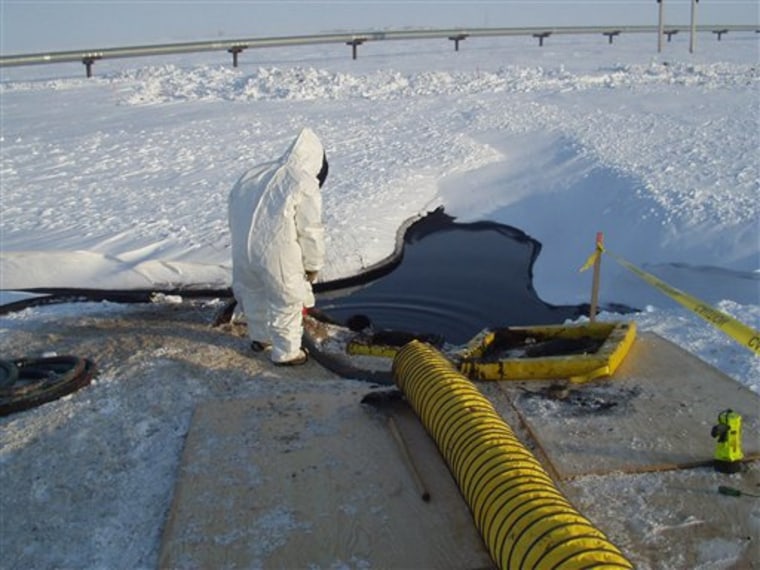A bubbling sound helped workers pinpoint a leak in a pipeline that allowed thousands of gallons of crude oil to spill onto the frozen tundra in Alaska's Prudhoe Bay.
State, federal and oil company officials said the total amount of oil spilled is still not known, but they discounted claims by an oil industry critic that the spill was much larger than BP Exploration (Alaska) Inc. is saying.
The breach was discovered at 1:40 a.m. Sunday inside a low-lying section of the 34-inch transit line, which leads to the trans-Alaska oil pipeline. The section where the leak occurred is covered by gravel to let caribou pass.
"All kinds of technology has been brought to the North Slope, and the way it was actually found was that someone heard a gurgling noise, put some lights on it, and saw it," Maureen Johnson, BP manager of the Prudhoe Bay unit, said during a briefing with reporters.
The source of the leak was found after enough snow had been removed from the site. The spill, discovered Thursday by a BP operator, prompted the company to shut down the processing plant, depressurize the line and block off both ends, but workers Sunday found that oil is still dripping from the breach.
"It's like putting a straw in soft drink and a finger on the straw. The fluid stays in the straw," said Matt Carr, onsite coordinator for federal Environmental Protection Agency. "Of course it's not a perfect seal. There's a little bit of dripping, but it's not a huge active leak."
With the location of the leak known, officials will focus on determining a cause, repairing the line and continuing the cleanup of spilled oil. Johnson said the spill, located about 650 miles north of Anchorage, has affected an area slightly less than two acres.
As of Sunday afternoon, crews had recovered 1,097 barrels — or more than 46,074 gallons — of crude and snowmelt.
The amount spilled is far greater than BP and government officials are saying, according to oil industry critic Chuck Hamel. Hamel, of Alexandria, Va., said he learned from onsite personnel that the spill volume is closer to 798,000 gallons, which would make it the second largest oil spill in Alaska, second only to the 1989 Exxon Valdez spill of 11 million gallons in Prince William Sound.
Hamel said meters record the volume flowing into the pipe as well as the amount leaving it.
"There's a 798,000 gallon discrepancy," he said in a phone interview. He declined to provide documentation of the discrepancy, however.
Hamel also said operators knew there was a leak at least 36 hours before the spill was found, because the smell of crude vapors was noted.
"They knew they had a problem," he said. "They could smell it, but they couldn't find it."
Johnson said the spill was discovered almost immediately after a worker smelled it. She said the spill size given by Hamel was news to her.
"I don't have any information about a spill that large," she said, adding the actual volume will eventually be determined. "We are going to find out ... I don't think anyone could hide a fact like that."
The focus now is on recovering the fuel, controlling and repairing the leak, and resuming full production as soon as possible, said Leslie Pearson, an on-scene coordinator with the Alaska Department of Environmental Conservation.
"We'll deal with rumors, but we're dealing with priorities here," she said.
BP and regulatory officials investigating the leak said much progress has been made in responding to the spill.
Crews have worked under considerable challenges, including temperatures dipping to 20 degrees below zero and deep snow hiding much of the spill. The leak was difficult to detect because oil can seep into insulation and the sheath surrounding the line, exiting at a distance.
"The progress has been just stunning," Johnson said.
